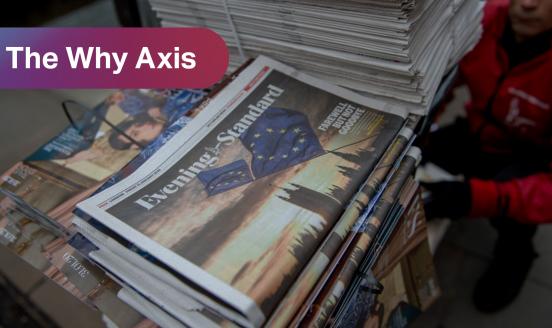The 2018 Nobel Prize: Growth and the environment
The 2018 Nobel Prize in Economic Sciences has been awarded jointly to William Nordhaus and Paul Romer for integrating respectively climate change and

Kevin Bryan on VoxEU has a recount of how the contributions of this year’s Nobel prize-winners came into existence and how they link to each other. Both Nordhaus and Romer have been running favourites for the award for many years, but the surprise is that the prize went to both of them together: Nordhaus is best known for his environmental economics, Romer for his theory of ‘endogenous’ growth. But on reflection, the connection between their work is obvious.
With Romer, we have a general equilibrium model for thinking about why people produce new technology. The connection with Nordhaus comes in a problem that is both caused and potentially solved by growth. Growth as a policy goal was fairly unobjectionable in 1960, but by the early 1970s environmental concerns had arisen. Nordhaus’ ‘integrated assessment models’ (IAMs) have Solow-type endogenous savings and make precise the trade-offs of lower economic growth against lower climate change, as well as making clear the critical importance of the social discount rate and the micro-estimates of the cost of adjustment to climate change.
J Bradford DeLong has a list of additional optional reading from the two Nobel laureates, and Economist’s View has more links. Timothy Taylor has a discussion of both laureates’ contributions, and was not expecting Romer and Nordhaus to win in the same year. Alex Tabarrok has a video discussing Romer’s contribution. Tyler Cowen has two separate biographic posts, one discussing Romer’s contribution and one discussing Nordhaus’.
Martin Sandbu argues that in our lifetimes, technological and environmental change have transformed how our economies work. Next time we marvel about our favourite smartphone app or worry about increasingly extreme weather, Sandbu argues, we should give a thought to Romer and Nordhaus. Thanks to them, we are in a better place to find good policies to deal with both innovation and climate change. Their prizes are well-deserved.
Peter Dorman wants to talk about the non-recipient whose non-prize is perhaps the most important statement. Nordhaus has been locked in debate for many years with Harvard’s Martin Weitzman, who rejects the entire social-cost-of-carbon approach on the grounds that rational policy should be based on the insurance principle of avoiding worst-case outcomes. His “dismal theorem” demonstrates that, under certain assumptions, the likelihood of tail events does not fall as rapidly as their degree of catastrophe increases, so their expected cost rises without limit - and this applies to climate scenarios.
Weitzman’s work is often invoked by those who believe much more aggressive action is needed to limit carbon emissions. Because of this, whenever economists speculated on who would win the econ Nobel, the Nordhaus scenario was always couched as Nordhaus-Weitzman. The Nordhaus-Romer combo is so artificial and unconvincing – Dorman argues – that it’s hard to avoid the impression that the prize not given to Weitzman is as important as the one given to Nordhaus, and that this is a clear political statement about how to deal with climate change and how not to deal with it.
Timothy Terrell is – unsurprisingly – of a different view, and thinks that the Nobel committee has promoted environmental regulation with its latest choice. Both economists see an expanded role for the State: Romer in his suggestions that government invest in research and development and employ patent laws to foster economic growth; Nordhaus in his belief that government should act to prevent adverse changes in climate. Conversely, Terell claims that free markets have been among the most powerful forces for cleaner technology and new ideas and that innovation, wealth creation, and healthier people are to be found among the most economically free parts of the world.
David Warsh argues that although Nordhaus and Romer, working separately on apparently different problems, were seldom mentioned together, they nevertheless combine to make a compelling point. Having led the effort to plausibly model the interaction of atmospheric carbon, climate change, and economic growth, Nordhaus made it possible to estimate damages caused by rising temperature. A carbon tax (which he and many other economists consider preferable to the emissions-trading system enshrined in the Paris Agreement) might prevent the most serious damage, starting experimentally low, then rising as necessary to meet the damage caused. Romer, in turn, created an analytic framework in which such a tax could plausibly be expected to produce a wave of innovations whose effect would be to lower carbon emissions.
Joshua Gans writes that the real reason Nordhaus and Romer should be linked is because of the way they have made their ideas persuasive – not to the general public or even politicians, but to economists. Back in the 1980s, Gans argues, both climate policy and science/innovation policy faced significant barriers moving forward. In each case, the main constituents who were holding up such policies were economists. In so doing, Nordhaus and Romer became present in every single policy discussion and tipped the balance towards action in cases where there were significant barriers and hurdles. Each thus showed how a careful accounting of economic forces can lead to progress, reduce uncertainty and make the case.
Noah Smith writes that, in addition to honouring two scholars whose contributions have deeply influenced their field, the award points to a crucially important issue to which the world is beginning to give short shrift – economic growth. As growth slows and productivity stagnates in the rich world, Romer’s insights are more important than ever.



